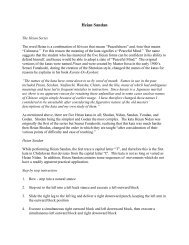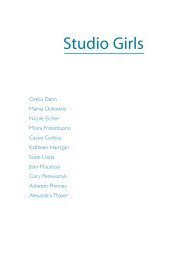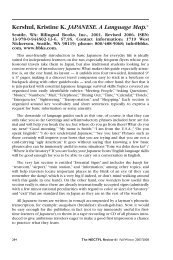selected paintings - Dickinson College
selected paintings - Dickinson College
selected paintings - Dickinson College
Create successful ePaper yourself
Turn your PDF publications into a flip-book with our unique Google optimized e-Paper software.
9<br />
Rural Landscape with Distant Church, n.d.<br />
Oil on canvas, 19 3/4 x 24 in. (50.2 x 61 cm)<br />
Signed: l.r.: Quincy; c.b.: Estate of Edmund Quincy [estate stamp]<br />
Exhibited: Spirit of the Past: The Paintings of Edmund Quincy, 1903-1997 (New<br />
York: Hirschl & Adler Galleries, 2000).<br />
Published: Zachary D. Ross, Spirit of the Past: The Paintings of Edmund Quincy,<br />
1903-1997 exh. cat. (New York: Hirschl & Adler Galleries, 2000), 33,<br />
cat. 4.<br />
Courtesy of Hirschl & Adler Galleries, NYC<br />
Rural Landscape with Distant Church is just one of a number of<br />
landscapes Edmund Quincy painted throughout his career.<br />
Upon first look, the viewer immediately notices the dirt path<br />
that cuts through the painting at a slight diagonal. The path<br />
draws the viewer’s eyes from the foreground of soft green grass<br />
and a solitary tree, through the middle ground of crops that are<br />
most likely corn, and brings the viewer’s eyes to rest on the distant<br />
church that is indicated in the title. At the end of the path,<br />
the viewer’s eyes naturally move up to the large, light sky. This<br />
agrarian scene was most likely inspired by rural America, as<br />
corn is a common American crop. Quincy’s use of diagonals,<br />
clear portrayal of the sky, and gentle treatment of the landscape<br />
through a color palette of soft blues, greens, browns, violets,<br />
and sensuous lines all suggest his strong background in academic<br />
painting. 1<br />
Quincy has placed the viewer in this painting slightly to<br />
the left of the path, and this position puts the viewer in a position<br />
to observe the path, rather than be on it. The path suggests<br />
movement or travel, but one could argue that Quincy does not<br />
want us as viewers “going into” the scene further. We are supposed<br />
to look at only the specific scene that Quincy has chosen<br />
for us and take in what it means; we are “spectators” of Quincy’s<br />
vision. This act of making the viewer a “spectator” is something<br />
that is also seen in the <strong>paintings</strong> of Edward Hopper, a contemporary<br />
of Quincy. In his book on Hopper, Lloyd Goodrich<br />
observed that, “Even when no window is physically present, the<br />
impression is sometimes conveyed of a remote observer….” 2<br />
This effect can be seen in Hopper’s painting, Pamet River Road<br />
(1934). 3 In this painting, a scene of a dirt road cutting through<br />
a residential area is very similar to the effect in Quincy’s Rural<br />
Landscape with Distant Church. In Hopper’s painting, as well,<br />
the viewer is set slightly off the road and is put into the role of a<br />
“spectator.” In both <strong>paintings</strong>, the viewer is being guided to see<br />
something specific. In Rural Landscape with Distant Church, one<br />
could suggest that Quincy was capturing the simplicity of an<br />
agrarian society, something that had been lost in the fast moving,<br />
industrial age of the early twentieth century. This idea is<br />
supported by the presence of a church which can be read as a<br />
sign of tradition and stability. 4<br />
Quincy’s manner of painting and his color choices are<br />
other issues that should be discussed in regard to this painting.<br />
Quincy could be characterized as a “representational” painter:<br />
22<br />
Quincy’s trees “look” like trees, and his shadows “look” like<br />
shadows. His work, however, is not confined to one type of<br />
painting, but rather his style, particularly in this painting, contains<br />
elements of the “impressionist ideal.” In this case, the<br />
“impressionist ideal” can be seen as a painting that represents<br />
elements of temporality and displays techniques that express<br />
opposing colors to represent light and darkness, rather than rendering<br />
them with grays and blacks. In this painting, Quincy<br />
used quick and short brushstrokes. This technique was used by<br />
Impressionists like Monet and Renoir to illustrate the temporality<br />
of their subjects and to reinforce the idea of a “captured”<br />
moment in time. 5 Quincy used a variety of brushstrokes in his<br />
<strong>paintings</strong>, so his choice of an “impressionist” method in this<br />
painting was quite purposeful. By using a technique that had<br />
been previously used to capture a moment, Quincy could be<br />
making a point about the temporality of his own image.<br />
Furthermore, Quincy’s choice of a soft color palette of<br />
blues, greens, browns, and violets is similar to that of<br />
Impressionist painters like Monet. Impressionists also incorporated<br />
many more warm colors like orange and pink, but the<br />
pastel quality of the colors in Quincy’s palette and the extensive<br />
use of violet make his <strong>paintings</strong> look similar, particularly to<br />
Monet’s Row of Poplars (1891) and Morning on the Seine near<br />
Giverny (1896-1897). 6 The Impressionists often used violet generously<br />
in their <strong>paintings</strong>. In pale shades, it could be used as a<br />
highlight and in darker shades, as a shadow. This technique of<br />
using violet instead of black, white, and gray gave the imagery<br />
in Impressionist <strong>paintings</strong> a more natural appearance; when an<br />
actual shadow is cast it is not black, but rather an altered color<br />
of the surface it is cast upon, and the same goes for a highlight<br />
or reflection. Violet is a more delicate color than black or white<br />
as well, and it complements a palette with more pastel colors<br />
like green and blue than more vibrant colors like red. Quincy<br />
used this same technique in this landscape with violet. He<br />
applied violet in the sky as a highlight and in the grass and trees<br />
as a shadow, giving his painting a similar appearance to that of<br />
an Impressionist painting. Quincy embraced the “impressionist<br />
ideal” in this painting, as he did in others such as Background of<br />
Metropolitan Industry, Venice Canal, and The Garden Wall.<br />
Hilary Smith<br />
1. Zachary D. Ross, Spirit of the Past: The Paintings of Edmund Quincy, 1903-1997 exh. cat.<br />
(New York: Hirschl & Adler Galleries, 2000), 12-13.<br />
2. Lloyd Goodrich, Edward Hopper (New York: Henry N. Abrams, 1993), 105.<br />
3. Goodrich, 226.<br />
4. Ross, 21.<br />
5. Lionello Venturi, “The Aesthetic Idea of Impressionism,” The Journal of Aesthetics and<br />
Art Criticism 1 (1941): 34-36.<br />
6. Paul Hays Tucker, Claude Monet: Life and Art (New Haven: Yale University Press, 1995),<br />
146.






